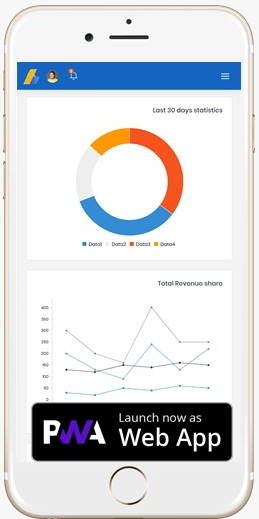Progressive Web App vs Native App - The Business Case for the Web
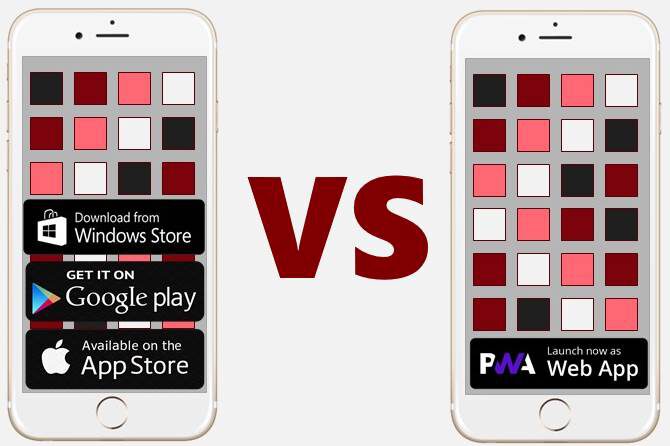
I get asked all the time why should a business chose a progressive web application over a native application.
A common debate: PWA vs Native App.
Why are Progressive Web Apps Better than native apps?
Is PWA the Future?
This makes sense because the traditional choice, at least for about a decade was a mobile app.
When you really break down the differences between PWAs and native apps it comes down to distribution channels.
As far as capabilities there are virtually no difference today.
Progressive Web Apps (PWA) are delivered using HTTPS rendered in a browser, can be added to the homescreen for a fullscreen, app-like experience. Native apps require an app store and multiple steps to download.
PWAs are designed to work on any device in any browser. Native apps are limited to a single operating system and require duplicate code bases
PWAs provide instant engagement, native apps take extra effort.
Native apps had all the coolness and the web was pretty weak a few years ago. And of course everyone was nuts about native apps.
It did not look great for the web.
But users have grew tired native apps as time progressed.
The web continues to add more and more new features that deeply integrate with the platform. And service workers make it easy to programatically create a rich offline experience among other things.
On the other side of the equation consumers got tired of native apps. So much so that no one downloads new apps anymore.
Yeah, yeah, I know overall store downloads are large numbers and growing, but...
Native app usage has concentrated around about 10 apps, mostly social media and almost all are owned by Facebook.
The money is made with two app types, games and media subscriptions. And if you are following the news Netflix has pulled AppStore payments, Spotify, Epic Games and others are publicly pushing back.
This means if you want to make it as a native app you have a tough road ahead of you.
But there is more and trust me it makes the web look like an amazing option for any business to select.
Oh I am sure I have got the ire of some by now and raised the curiosity of others.
So let's start looking at how progressive web apps stack up against native applications. You will learn why your business should almost always select a PWA.
Before we start, ask yourself - Why build a mobile app when no one uses it?
- What are Native Applications? And Why Are They Dying
- How Native Applications are Used
- The Web's Super Power
- Progressive Web Apps and Native Have Feature Parity
- Will PWA Replace Native Apps?
- Why are Progressive Web Apps Better than Native Apps?
- Action Items For Businesses
What are Native Applications? And Why Are They Dying
Native applications are tightly coupled to a device type and operating system. They are distributed through platform specific app stores and subject to the platform's arbitrary review before distribution. Monetization or payment options are limited to the operating system and take 10 times the normal fees from developers.
App stores apply a 15-30% fee of your pre-tax revenue of any transaction. You are limited to using the app store payment service and cannot chose your payment processor.
Beyond taxing you for digital purchases app stores are notorious for rejecting application submissions and updates. Each app store has strict guidelines for app approval. Often these guidelines are ambiguous and arbitrarily applied to reject and remove apps from stores.
Apple is driving brands insane lately. I know my inbox is heating up with more and more wanting to replace native applications with progressive web applications.
They have either been rejected, had an update blocked or are concerned as they watch others in their niche get blocked.
The restrictions are sold as a way to keep application user experience high as well as secure.
This can be debated. The Apple 4.2.6 clause alone is left ambiguous so they can reject any app they just decide they don't like.
I mean what does it really mean to be 'app-like'?
Apple won't tell us!
How Native Applications are Used
Its a mobile world, the web is just part of it. And depending on how you read usage statistics you might think the web is dead.
But that is not true.
Not even close.
Native applications dominate user screen time. They account for 87% of the time we spend on our devices.
This leaves a paltry 13% for our web sites.
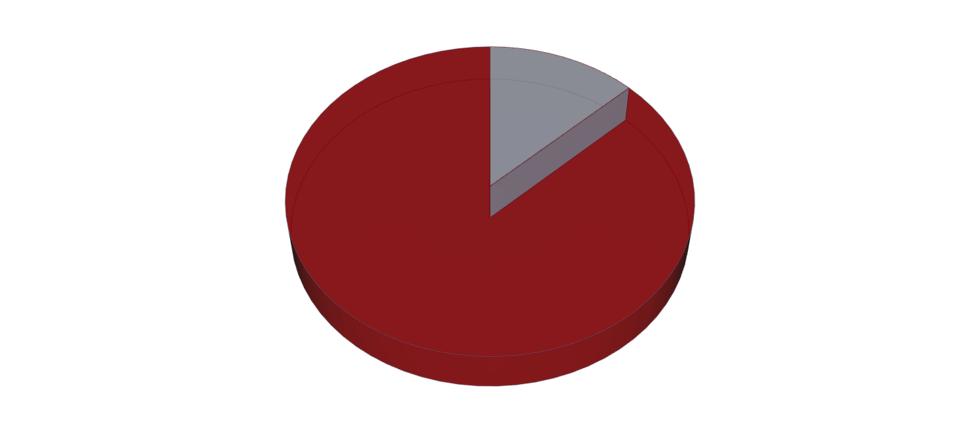
A deeper dive into the 87% native app time is revealing. The vast majority of that time is spent in Facebook. And I mean almost all the time is in Facebook owned apps.
The top 6 apps include Facebook, Facebook Messenger, Facebook's Instagram, Facebook's WhatsApp and a spread between SnapChat, YouTube and GMail. According to comScore's Mobile Metrix June 2015 report, 80% of app time is Facebook.
App popularity beyond those brands starts slipping, fast after the 6th application. We use less than 10% of the apps we download more than once. And after 3 months most of those unused apps are removed.
I realize those stats are a little stale by now, but not by much.
The average adult downloads ZERO apps in a given month. Most app downloads occur when a new phone is purchased and that activity is downloading apps the customer already has an established relationship.
The time we engage with apps is very telling. When you think about Facebook, it is really another browser. You are only allowed to surf a closed set of content, like any other browser. The difference is Facebook hosts and 'owns' all the content, we just publish for them.
If you accept the Facebook browser model then the vast majority of time on a mobile device is spent consuming...the web.
On top of that, the cost to acquire a new app install is between $4-12. Compare that to how much a pay per click advertising campaign cost, averaging roughly $0.31 per visit.
According to research mobile apps lose 20% per step in the download and install process.
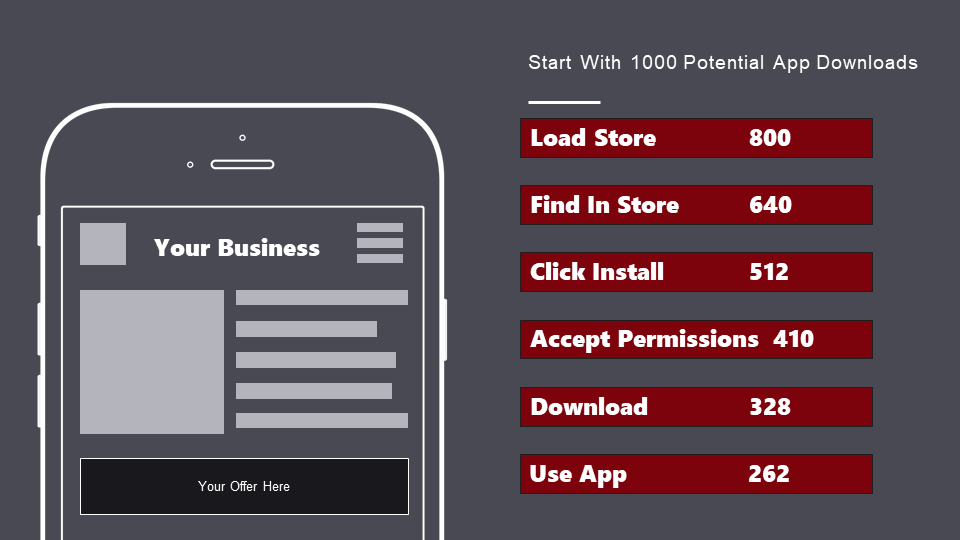
"In a consumer mobile app, every step you add to your on-boarding flow will cost you about 20% of users."
Gabor Cselle
This means you can reach your target market cheaper and easier, while building that valuable customer relationship.
Even more important, 90% of the apps we download are removed after only 1 use. That means the majority of apps have a terrible ROI. Most simply lose money.
The Web's Super Power
That is not the end of the story. The web has a super power native apps may never get, reach. This means I can send you a link to a specific page in a site and your browser will load that content.
Or you can be discovered in a search result.
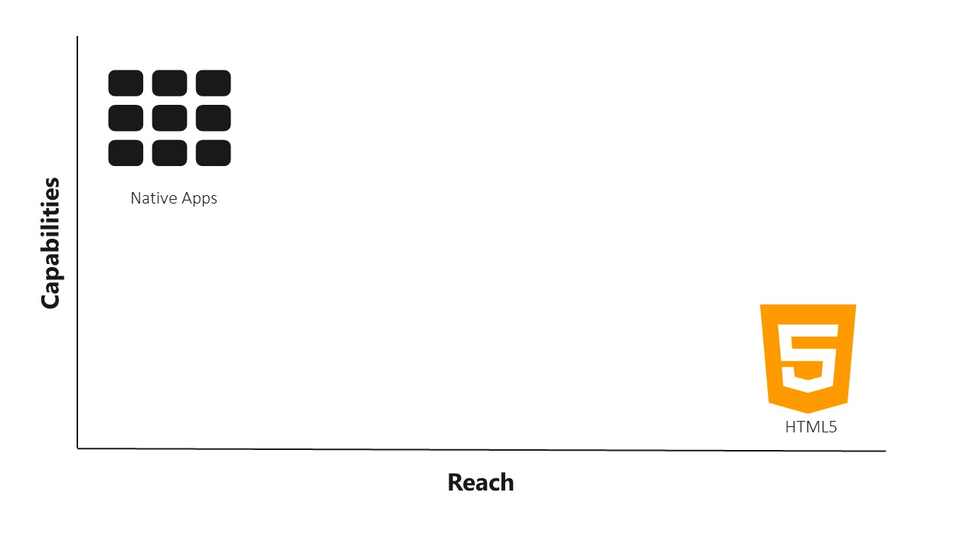
An app would require you to download the app (assuming you have not, and most haven't) then find the content in the app.
Sure you can share some content from an app on social media, but it is the content, not the app itself. And typically the content is available via a URL to web content.
But wait, what about platform integration?
Yes native apps have an advantage here, but a diminishing one.
Progressive Web Apps and Native Have Feature Parity
Before I continue, I want you to ask yourself what is a platform integration you must have?
I bet you struggled to answer that question. And if you came up with something, then you probably do not realize there is a web API for that.
Newer web APIs open up access to common platform features. Native push notifications are one of the more exciting platform features to land in recent years.
More are on the way. Blue Tooth, USB, camera, Geo-location, sharing and many other APIs are available and many have been around for a decade.
Others like battery levels, native file system access and network quality are in the works.
Most of these new APIs are gated behind HTTPS to ensure the web is safe. SSL encrypts data between the server and the user agent (browser), stopping potential man in the middle attacks.
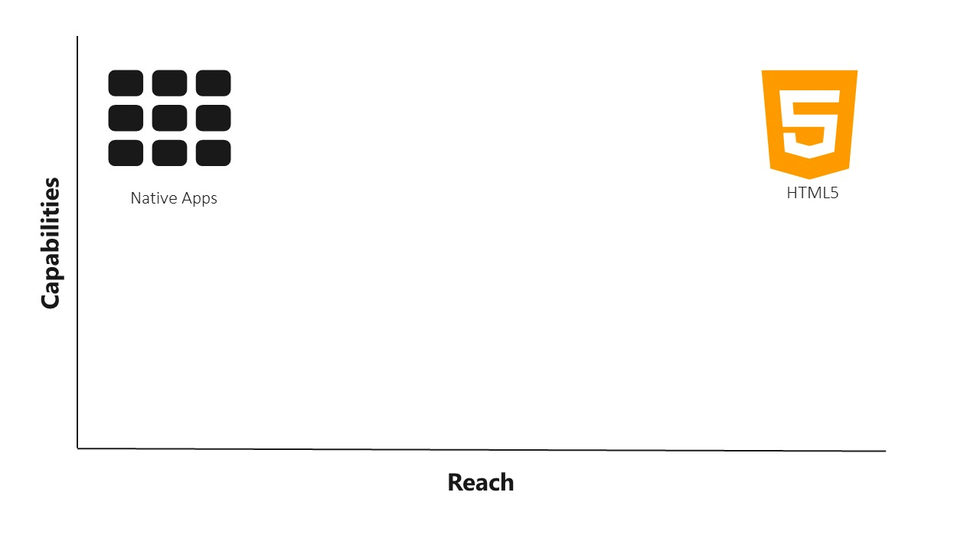
As PWAs gain more and more platform integration the line between native apps and the web blurs and practically vanishes.
The web's natural capability growth has not been lost on different platform vendors. Android Oreo shipped supporting PWAs to WebAPK or an automatic creation of an Android application when a PWA is added to the homescreen. The latest Android supports directly submitting PWAs to the Play Store.
They followed up in the latest Android with Trusted Web Activities, sort of a next-level WebAPK. At a high level TWAs elevate your PWAs to be more app-like than WebAPKs do.
Microsoft is taking PWAs to the next level. When Windows 8 launched web sites could be added to the Windows store if they were served using HTTPS and referenced a valid web manifest file. These are called Hosted Web Apps.
Microsoft will be encouraging developers to make these apps available in the Store and make them able to work with Windows 10 features, like Action Center. Microsoft is planning to crawl and index Progressive Web Apps, convert them to APPX and make them searchable and browsable in the Store Mary Jo Foley
Mary Jo Foley
As Microsoft watched the momentum behind progressive web applications they saw Hosted Web Apps and a Progressive Web Apps were essentially the same thing. Today, they are re-branding Hosted Web Apps as Progressive Web Apps.
Not only are they adopting the PWA term, they are offering a path to make them full blown native applications with very little friction. They are even finding your PWA on the web and automatically submitting it to the Windows Store!
PWAs should be able to progressively enhance to full-fledged apps
Jacob Rossi
Do you notice a trend? That quote is very similar to Alex Russell's.
As Microsoft has increased their public messaging behind PWAs, the media has started realize how important this move is.
Technical critic, Paul Thurrott stated this about the Microsoft PWA strategy:
This apps platform is a perfect storm of the right ideas at the right time, a spiritual combination of the cross-platform dreams for Java and the pervasive nature and openness of the web.
Paul Thurrott
I love how he calls it a 'spiritual combination'!
With the upcoming switch to the Chromium base, Edge will offer the same add to desktop experience Chrome has recently shipped as well as service worker background sync.
Oh and don't forget FireFox, Samsung Internet and just about every other browser. They all support service workers and many of the device integration APIs.
Even Apple offers basic service worker support and has always had an add to homescreen path.
Since my college days back in the early 90s the web has made the promise of cross-platform. And keeps delivering, even as the bar of expectations rises. It make take a little while for it to catch up, but the web platform always does.
When it catches up, the web always supplants the native option(s). This does lead to a lot of misguided messages around progressive web apps, but don't fear most of the negatives you see repeated are simply false.
What this means is progressive web apps unlock superpower features to enhance your website. Even if the consumer's browser does not support progressive web app features, it will still just work, hence progressive.
Don't believe me?
Those brands shipping progressive web apps all report improved engagement and performance values on browsers that don't support PWA technology yet.
Why? Because when you adhere best practices your user experience improves. Consumer all love great experiences and you reap the rewards.
Unlocking brand new user experience features enables your site to engage with your customers at a much deeper level.
The web can do this because it now includes the traditional super powers of reach and low creation (development) friction. An now it also offers many platform integrations, like push, deep camera access, etc.
Will PWA Replace Native Apps?
Many companies like Facebook, Microsoft, Google, Twitter, Starbucks and other brands you are familiar with have already replaced native apps or in the process of doing so.
They are choosing PWAs over native or mobile apps because they provide full control over their experience, ability to market and of course lower development and maintenance costs. Consumers are choosing progressive web applications over native options because they are easier to access, require less disk space and are not tethered to a tedious app store experience.
I had dozens inquire with me over the past year about replacing their native app with a progressive web application.
The top 2 reasons businesses seem to want to migrate from native to the web are:
- fear of Apple censoring or removing their app
- lack of reach to promote their application or high marketing costs to acquire customers
The fear of having an application accepted and then retained in any of the app stores is real. Specifically Apple's App Store, which is extra aggressive in restricting what apps are listed in the store.
I have written about Apple's quality guidelines and how they affect your ability to submit and maintain an App Store presence. These heavy regulations are starting to decimate the mobile app ecosystem as companies and governments are suing Apple over these practices.
What about the ability to market a native application over progressive web applications?
Again, I covered this topic earlier in this article. But let's just review.
Marketing mobile apps is expensive. Just to get someone to download an app cost $10-30. Then roughly 10% will use the app more than once.
That means it costs $100-300 to acquire a new customer. I hope your product or lifetime customer value is very high.
The web has multiple channels of entry, particularly organic search and search engine marketing.
The good news is PWAs are organic search engine friendly. If you nail the PWA features you should have a solid technical SEO platform and rank easier for your target keywords.
That solid technical base will also make any PPC or remarketing campaigns cheaper because Google and others will charge less because your landing page's quality is higher.
This means you will have cheap, top of the funnel traffic.
But wait there's more.
Once someone visits your PWA you can design the service worker to pre-cache key pages and assets on their device. That means the next visit will feel instant, or better than native and that will improve your ability to convert them to a customer.
Other factors I cover in this article are also leading more businesses and brands to phase their mobile apps out of the stable and completely replace them with their web experiences.
So yes, progressive web applications are replacing native applications. Both businesses and consumers are choosing PWAs as the channel to engage.
PWAs offer that low friction experience for consumers and lower cost channel for businesses.
So both sides win.
Why are Progressive Web Apps Better than Native Apps?
Let's review some of the key points I made.
- Consumers Stopped Downloading Native Apps in 2015
- Marketing Mobile Apps is Expensive
- The Web Has Feature Parity with Native Apps
- App Stores can and do remove and reject apps all the time
- Consumers Engage More with the Web Than Native Apps
- PWAs Offer a Cheap Way to Reengage with Clients Through Homescreen Icons, like Native Apps
- Many Brands Have Already Begun a Migration From Mobile to PWA
- Search Engines Are Designed to Reach Customers
- Hyperlinks Allow Direct Access to Information Consumers Want
Action Items For Businesses
By now you should know why progressive web applications are the best channel to grow your business and engage clients.
If you are still on the fence, ask yourself if you have a website and or an app now?
I bet you answered yes to the website and probably not an app. Some of you have apps, and maybe you are thinking about the issues raised in this article.
If you are still not sold, you need to admit you needed your website to sell your app. Why force the visitor to leave your website, go to a third party app store, then go through 8 more steps to load your app.
Then they have to find the content they actually wanted in the first place.
Even if a website visitor does not add your PWA to their homescreen your PWA is installed as soon as they visit any page on your site.
Every page on your site is an entry point to install your PWA.
To take it to the next level to get more 'app' features like a homescreen icon all you need to do is ask them.





